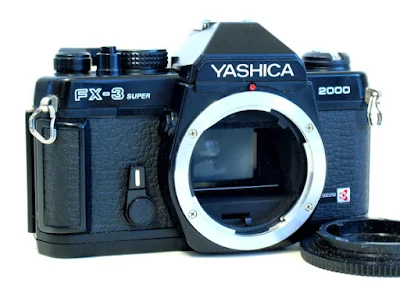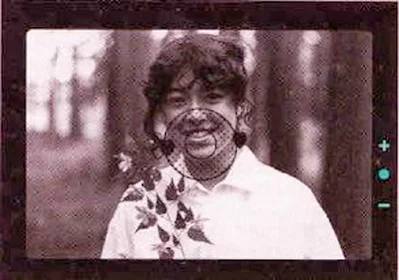All these cameras are fitted with the C/Y lens mount system, the same as fitted on the Contax series of 35mm SLR film cameras, designed to use Carl Zeiss T* series lenses.
The all-mechanical FX-3 Super 2000 is fitted with a vertical-travel metal focal-plane shutter with a shutter speed range from 1 to 1/2000 second, and B, with flash synchronization at 1/125 second.
Metering is TTL (Through-the-Lens) center-weighted, with an EV range from EV 2 to EV 19 (ISO 100 with 50mm F1.4 lens). The camera accepts film ISO speeds from 12 to 3200 and comes fitted with a mechanical 10-second delay self-timer.
As developed from the FX-3 Super, the FX-3 Super 2000 has its top shutter speed increased from 1/1000 to 1/2000 second, comes with a new finger grip design, a flash-ready indicator in the finder, and the relocation of the meter switch to the shutter release button.
Within the updates, the FX-3 Super still retains its robust and lightweight construction and simplicity of use.
Yashica FX-3
Enjoy the videos and music you love, upload original content, and share it all with friends, family, and the world on YouTube.
Looking back to where it started, the FX series was one of the results of the collaboration between Carl Zeiss and Yashica on the 'Top Secret Project 130', which started in 1973. As a result of the union, Zeis went the way of the electronically controlled Contax series of 35mm SLR film cameras, and the T* series lenses, while Yashica opted for their own line of consumer-grade FX-series cameras and their proprietary DSB, YUS, ML, and MC zoom lenses.
Basic Camera Features
Available only in black, the camera is rather elegant with its simple curved edge design and an uncluttered front plate, with all controls and features logically located on the top plate.
The front of the camera is almost all plain aside from the lens mount housing, to the left of which is the self-timer mechanism, the lens release button on the vertical side of the lens mount housing, and the finger grip, which sets the Super 2000 distinct from other FX-3s.
The top plate carries the hot shoe on top of the pentaprism, a solitary film rewind crank on its left, and on the right is the shutter speed dial, integrated with the film ISO dial, shutter release button, film forward crank, and the auto-reset film counter window.
The Super 2000 has an all-plain back, aside from the viewfinder window. The film back is a non-interchangeable hinge type.
The bottom plate of the FX-3 is equally sparse, with the battery chamber cover, rewind release button, and tripod socket.
The film box is a standard easy-load system with the film cassette chamber to the left, followed by the shutter window, sprocket gear, and the take-up spool on the right.
Viewfinder Readout
The FX-Super 2000 is fitted with a split image/microprism screen with a 92% field of view. Metering information is represented by a trio of LEDs located vertically on the lower right side of the screen. The LEDs are a minus symbol (-) for underexposure, a plus (+) sign for overexposure, and a dot if the exposure setting is proper.
When used with a compatible Yashica or Contax flash unit, a flash-ready signal above the exposure LEDs will light up when the flash is fully charged.
Manual Shooting Mode
In a fully manual shooting mode, photographers use both changes to the shutter speed and variations to the lens aperture opening to get the best exposure setting before the image is captured. A good way to start is to decide, initially, on the shutter speed you want to use, and after framing and focusing the image, vary the lens aperture opening until the optimum exposure is reached, and release the shutter.
The other option is to start with a fixed lens aperture opening and vary the shutter speed setting for optimum exposure. Both methods are equally acceptable; a fast shutter speed may be used to freeze action sports shots, while using a wide lens aperture may get you good bokeh shots, depending on the minimum aperture of the lens.
Self-Timer / Mirror Lock-Up
The self-timer on the FX-2 Super 2000 works in the mirror-up position, which means that the camera can also be used to take vibration-free shots secured on a tripod or placed on a hard surface.
The self-timer is enabled by pushing the timer lever to the left after the film frame has been advanced, and the delay is activated once the shutter is released.
Exposure Compensation
Exposure compensation is not directly available on the FX-3 Super 2000, though you can manipulate this by adjusting either the lens aperture opening or the shutter speed setting.
A 2X exposure compensation is activated per change of the lens aperture opening (e.g., from F11 to F16) or per shutter speed change (e.g., from 1/125 second to 1/100 second).
Battery
The FX-3 2000 Super requires a pair of LR44 cell batteries to operate the metering system; otherwise, everything else is mechanical.
Camera Body Weight
The camera's body weight is 445 grams without batteries.
Yashica ML Lenses
The Yashica ML line of lenses was the pro-level Multicoated lenses, marketed as a pro-grade lens in a slot between the consumer-grade DSB line and the state-of-the-art Zeiss T* lenses. These lenses were made in Japan at the same factory where the T* lenses are manufactured. Due to the difference in the use of coatings, these lenses have a slightly less contrasty, classic look. They are, however, renowned for their vivid color rendition.
Using The Camera
Being lightweight, and even with the Yashica ML 50mm f/1.8 mounted, the FX-3 2000 Super is a delight to carry around. It fits right in your hands, and will still catch the glance even in the company of other likes, say, the Olympus OM-1s, Nikon FM, and Pentax MX. It is even the lightest of them all.
As a fully manual shooter, the FX-3 2000 Super is very easy to use; metering information for the center-weighted exposure metering system is direct, presented via the trio of LEDs. Not a problem if the batteries are depleted, the camera is all mechanical, and the shutter and aperture can be configured based on the Sunny 16 rule.
One quick piece of advice when you are taking very long-exposure night shots is to disable the light meter, as the glow of the red LED will tend to bleed onto the film to produce a dim, red glow on the edge of the image. Just remove the batteries, and you are good to go.
Use the self-timer to lock up the mirror for images that are free of vibration. The resulting image might be a tad sharper, depending, of course, on the lens you have mounted> Here, you have a choice from the wide range of C/Y mounts that are available.
At the end of the day, I am sure you will find that the Yashica FX-3 Super 2000, as an all-manual SLR, is a very capable camera. Not being a big name does help you get it at a very, very reasonable cost, whereas you might instead splurge and invest in the prime Planar T*. Do try one out, if you get the chance, and be surprised!





















may I share your blog and video and translate to Malay..?
ReplyDeleteThank You
Yes, you may, please be kind enough to provide a link back to this page. The video is not mine, it it sourced from YouTube. Thank you.
DeleteCan this camera compatible with Zeiss AEG and others like MM as well as MMJ?
ReplyDelete'these cameras are fitted with the C/Y lens mount system, the same as fitted on the Contax series of 35mm SLR film cameras which were designed to use Carl Zeiss T* series lenses.'... if this helps, thanks
Delete